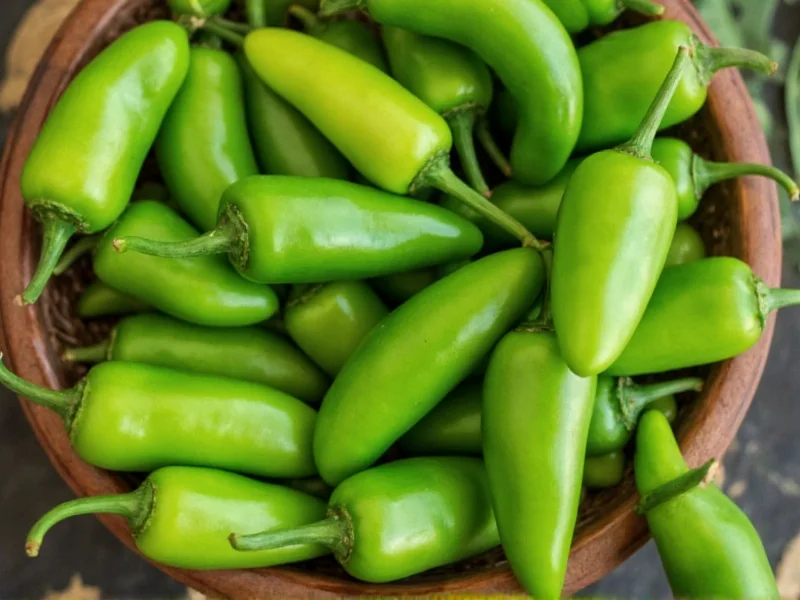Jalapeño peppers typically measure between 2,500 and 8,000 Scoville Heat Units (SHU), placing them in the mild to medium range of the chili pepper heat spectrum. This means they're noticeably spicy but significantly milder than hotter varieties like habaneros or ghost peppers.
Understanding where jalapeños fall on the Scoville scale helps home cooks and food enthusiasts gauge their heat level for recipes and personal preference. The Scoville scale, developed by pharmacist Wilbur Scoville in 1912, measures the concentration of capsaicin—the compound responsible for a pepper's heat—in Scoville Heat Units. Modern testing uses high-performance liquid chromatography for precise measurements, but the Scoville scale remains the standard reference for comparing pepper heat levels.
Understanding the Scoville Scale Measurement
The Scoville scale quantifies pepper heat by measuring how much sugar water is needed to dilute the capsaicin until it's no longer detectable to human taste testers. While laboratory methods have evolved, the scale provides a consistent framework for comparing how hot are jalapeno peppers on the scoville scale against other varieties. This measurement helps consumers make informed decisions when selecting peppers for cooking or understanding jalapeno pepper heat level comparison.
Where Jalapeños Rank Among Common Peppers
Jalapeños sit comfortably in the middle-to-lower end of the heat spectrum. To put their 2,500-8,000 SHU range in perspective, consider this comparison of popular peppers:
| Pepper Variety | Scoville Heat Units (SHU) | Heat Level |
|---|---|---|
| Bell Pepper | 0 SHU | Mild |
| Pepperoncini | 100-500 SHU | Mild |
| Jalapeño | 2,500-8,000 SHU | Mild-Medium |
| Serrano | 10,000-23,000 SHU | Medium-Hot |
| Habanero | 100,000-350,000 SHU | Very Hot |
| Ghost Pepper | 855,000-1,041,427 SHU | Extremely Hot |
Why Jalapeño Heat Varies So Much
Several factors contribute to the wide range in jalapeño heat levels, explaining why some jalapenos are hotter than others:
- Genetics: Different jalapeño cultivars naturally produce varying capsaicin levels
- Environmental stress: Drought, temperature fluctuations, and soil conditions can increase heat production
- Ripeness: Red jalapeños (fully ripe) tend to be slightly hotter than green ones
- Part of the pepper: The placenta (white ribs) contains the highest concentration of capsaicin
Interestingly, the same jalapeño plant can produce peppers with different heat levels. A jalapeño that appears smooth and dark green typically indicates lower stress and milder heat, while corking (white lines on the skin) often signals higher capsaicin production due to environmental stress. This natural variation in jalapeno scoville units range makes each pepper unique in its heat profile.
Practical Implications for Cooking
Knowing the jalapeño's position on the Scoville scale helps you make informed decisions in the kitchen when comparing jalapeno heat to other peppers:
- For milder dishes, remove seeds and white membranes where most capsaicin concentrates
- When substituting peppers, remember that serranos (10,000-23,000 SHU) are 2-3 times hotter than jalapeños
- Fresh jalapeños provide brighter heat than canned, which mellow during processing
- Roasting jalapeños reduces perceived heat while enhancing flavor complexity
Safety Considerations with Jalapeños
While jalapeños aren't extremely hot, proper handling prevents discomfort when working with factors affecting jalapeno pepper spiciness:
- Wear gloves when handling many jalapeños to avoid skin irritation
- Avoid touching your face, especially eyes, after handling hot peppers
- If skin irritation occurs, use milk or oil-based products to neutralize capsaicin (not water)
- Wash cutting boards and knives thoroughly after preparing hot peppers
Measuring Jalapeño Heat at Home
Though precise Scoville measurements require laboratory equipment, you can gauge relative heat:
- Taste a small piece of the pepper (start with the tip)
- Note how quickly heat registers and how long it lasts
- Compare to a known reference (like another jalapeño)
- Consider the number of seeds and amount of white membrane
Remember that individual tolerance varies significantly—what seems mild to one person might feel hot to another. This subjectivity is why the Scoville scale uses standardized testing methods rather than individual taste tests when discussing how hot are jalapeno peppers on the scoville scale.
Conclusion
Jalapeños' 2,500-8,000 SHU range makes them versatile for adding moderate heat to dishes without overwhelming other flavors. Understanding their position on the Scoville scale helps you select the right pepper for your recipe and adjust heat levels to personal preference. Whether you're making salsa, poppers, or simply adding kick to everyday dishes, knowing how jalapeños compare to other peppers ensures better cooking results when using jalapenos in cooking safely.
Frequently Asked Questions
How hot are jalapeño peppers compared to other common peppers?
Jalapeños (2,500-8,000 SHU) are significantly milder than habaneros (100,000-350,000 SHU) and ghost peppers (855,000+ SHU), but hotter than milder peppers like pepperoncini (100-500 SHU). They're about 2-3 times milder than serranos, which measure 10,000-23,000 SHU.
Why do some jalapeños taste much hotter than others?
Jalapeño heat varies due to growing conditions (drought increases heat), ripeness (red jalapeños are often hotter), genetics, and even which part of the pepper you eat. The white membranes and seeds contain the highest capsaicin concentration. Environmental stress like temperature fluctuations can also boost heat production.
Can I reduce the heat of jalapeños for cooking?
Yes, removing the seeds and white membranes (placenta) significantly reduces heat, as these parts contain most capsaicin. Soaking sliced jalapeños in milk or salt water can also mellow the heat. Roasting jalapeños changes the flavor profile and can make the heat feel less intense while adding smoky depth.
Are red jalapeños hotter than green jalapeños?
Generally, yes. Red jalapeños are fully ripe versions of green jalapeños and often measure slightly higher on the Scoville scale. However, the difference isn't dramatic—both fall within the 2,500-8,000 SHU range. Red jalapeños typically have a sweeter, fruitier flavor alongside their heat compared to the brighter, grassier notes of green jalapeños.











 浙公网安备
33010002000092号
浙公网安备
33010002000092号 浙B2-20120091-4
浙B2-20120091-4